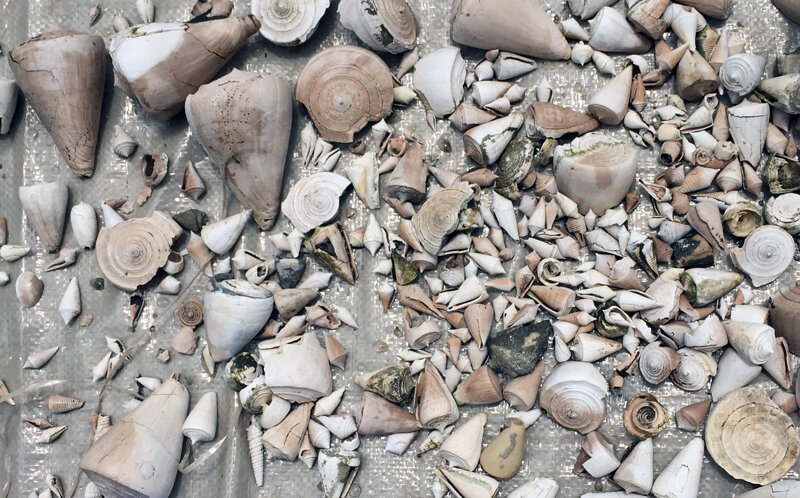Jonathan R. Hendricks
Dr. Jonathan R. Hendricks
Associate Director of Science Communication
Concentration
Evolution and Systematics of Cenozoic Mollusks, Digitization of Paleontological Collections for Education and Research
Education
B.S., 1999, University of Wisconsin-Madison
Ph.D., 2005, Cornell University
Additional Links
Fossil cone snail shells collected from the Miocene Gatun Formation of Panama.
Cone snail fossil from the Miocene Gatun Fm. of Panama viewed under ultraviolet light.
Overview
Dr. Jonathan Hendricks is Associate Director of Science Communication at PRI. Prior to coming to PRI in 2016, he was an associate professor in the Department of Geology at San Jose State University (part of the California State University system), where he taught multiple courses on paleontology and also mentored graduate student research. Besides managing PRI’s publications, he is also active in paleobiological research and outreach activities associated with the National Science Foundation-supported Digital Atlas of Ancient Life project.
In addition to his work at PRI, Hendricks is currently serving a three-year term as the Paleontological Society’s Treasurer/Chief Financial Officer.
Research Focus
Examples of ancient coloration patterns revealed by UV light. Top row: three fossil shells (PRI 66199, PRI 66166, and PRI 66158) from the Neogene of the Dominican Republic photographed under regular light; all scale bars are 1 cm. Middle row: the same specimens photographed under longwave UV light. Bottom row: reversed images that show how fluorescing regions correspond to parts of the shell that were once darkly pigmented. From Hendricks (2015) in PLoS ONE.
Much of Hendricks’s current research is focused on the evolutionary history of cone snails (family Conidae), which are renowned today for their dazzling shells, deadly venoms, and great species diversity.
Hendricks is currently researching the Neogene history of cone snails in tropical America to better understand how environmental changes associated with the Pliocene closure of the Central American Seaway (due to the formation of the Isthmus of Panama) affected the evolution and extinction of different clades of cone snails across this region and through time. This research is conducted using a variety of techniques, including “total evidence” phylogenetic approaches that integrate data from the fossil record with molecular and morphological datasets developed from modern species.
Outreach Focus
Hendricks is also interested in using museum fossil collections to develop new digital resources for education and outreach. He developed and leads the Digital Atlas of Ancient Life project, which is focused currently on the generation of new digital field guides to fossils and other online resources to help people learn about ancient life, including an open access paleontology “textbook” called the Digital Encyclopedia of Ancient Life that is currently under development. His work in this area is supported by two grants from the National Science Foundation.
Additionally, Hendricks is leading the development of PRI’s new Earth@Home website, which will eventually become a one-stop-shop for anyone to learn about the Earth and its 4.6 billion year history.
Honors, Awards, and Appointments
Adjunct Associate Professor, Department of Earth and Atmospheric Sciences, Cornell University
Paleontological Society Treasurer (current)
Paleontological Society Distinguished Lecturer, 2016-2017
Curriculum Vitae
Recent Papers
Phuong, M. A., M. E. Alfaro, G. N. Mahardika, R. M. Marwoto, R. E. Prabowo, T. von Rintelen, P. W. H. Vogt, J. R. Hendricks, and N. Puillandre. 2019. Lack of signal for the impact of conotoxin gene diversity on speciation rates in cone snails. Systematic Biology 68(5): 781-796.
Allmon*, W. D., G. P. Dietl*, J. R. Hendricks*, and R. M. Ross. 2018. Bridging the two fossil records: paleontology’s big data future resides in museum collections. Pp. 35-44, in: Museums at the Forefront of the History and Philosophy of Geology: History Made, History in the Making, G. D. Rosenberg and R. M. Clary (eds.), Geological Society of America Special Paper 535. *Authors contributed equally and are listed alphabetically.
Hendricks, J. R. 2018. Diversity and preserved shell coloration patterns of Miocene Conidae (Neogastropoda) from an exposure of the Gatun Formation, Colón Province, Panama. Journal of Paleontology 92(5): 804-837.
Hendricks, J. R., A. L. Stigall, and B. S. Lieberman. 2015. The Digital Atlas of Ancient Life: delivering information on paleontology and biogeography via the web. Palaeontologia Electronica 18.2.3E.
Hendricks, J. R. 2015. Glowing seashells: diversity of fossilized coloration patterns on coral reef-associated cone snail (Gastropoda: Conidae) shells from the Neogene of the Dominican Republic. PLoS ONE 10(4): e0120924.





